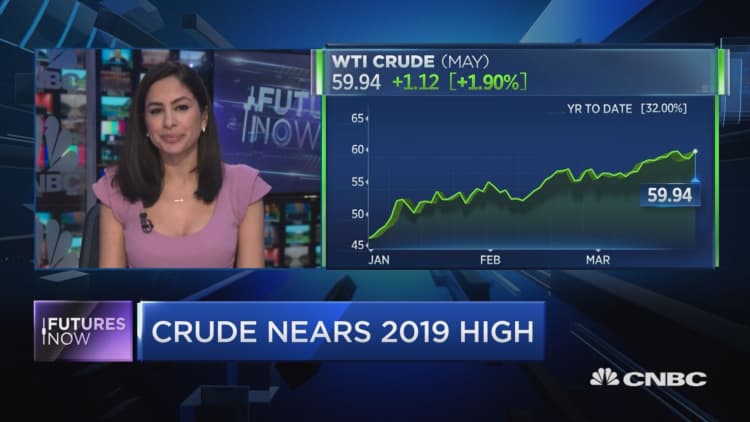Oil prices fell on Wednesday after government data showed U.S. crude stockpiles unexpectedly rose last week, though disruptions to Venezuela's crude exports limited losses.
U.S. West Texas Intermediate crude futures settled 53 cents lower at $59.41 per barrel, posting a nearly 1 percent loss on Wednesday. International benchmark Brent crude fell 14 cents at $67.83.
U.S. crude inventories rose last week by 2.8 million barrels, compared with analysts' expectations for a decrease of 1.2 million barrels, the U.S. Energy Information Administration said.
"The report was bearish relative to expectations, as crude inventories rose due, in part, to a steep drop in exports week-on-week," said John Kilduff, a partner at Again Capital in New York. "The rise in crude oil inventories at Cushing was another bearish data point."

Crude stocks at the closely watched delivery hub in Cushing, Oklahoma rose by 541,000 barrels and exports fell 506,000 barrels, the EIA said.
Venezuela's main oil export port of Jose and its four crude upgraders were unable to resume operations following a massive power blackout on Monday, the second in a month.
Crude exports from the key OPEC member have dropped sharply since Washington in January banned U.S. refiners from buying Venezuelan oil.
Oil prices have risen more than 25 percent this year, supported by supply curbs by OPEC and other major producers, along with U.S. sanctions on exports from Venezuela and Iran.
"Yo-yo price swings have become the norm in the oil market," PVM analyst Stephen Brennock said in a note. "Market focus switched back to supportive supply considerations. They include, most notably, Venezuela's deepening oil woes."
Brent crude traded in a relatively narrow range of $64 to $69 a barrel throughout March, reflecting the tension between tightening supplies and concerns over global demand.
At the same time, disruptions in the United States have also lent support.
The U.S. Coast Guard on Monday reopened portions of the Houston Ship Channel with restrictions on waterways affected by a petrochemical leak and fire outside Houston that have disrupted ship traffic.

Crude flows from two key shale basins to the Cushing, Oklahoma delivery point for U.S. crude futures slowed in March due to winter production outages, dealers said.
Hedge funds and other money managers have increased bets that demand for oil will be sustained, even as the market rallied last week.
"We seem to have reached a state of equilibrium after the recent headline-driven choppy trading and we need to see some new impetus for price direction," said Jeff Halley, senior market analyst at OANDA in Singapore.
That is unlikely until a conclusion is reached on U.S.-China trade talks, he added, referring to negotiations due to restart on Thursday as the world's two largest economies seek to end an eight-month old trade war.
Worries about demand have limited oil's rally as manufacturing data from Asia, Europe and the United States pointed to an economic slowdown.
— CNBC's Tom DiChristopher contributed to this report.

